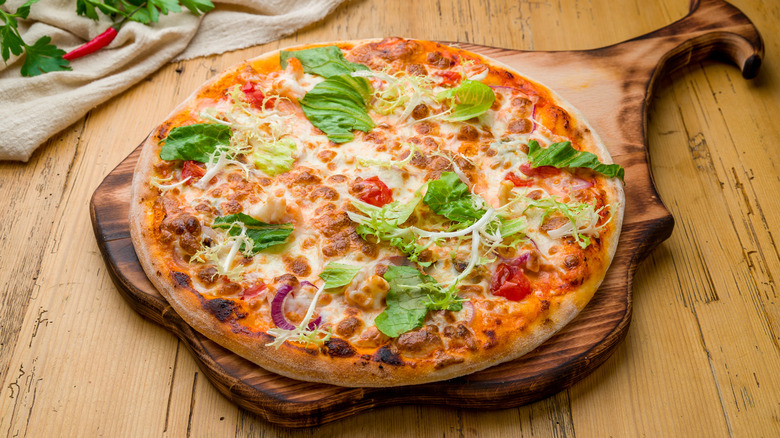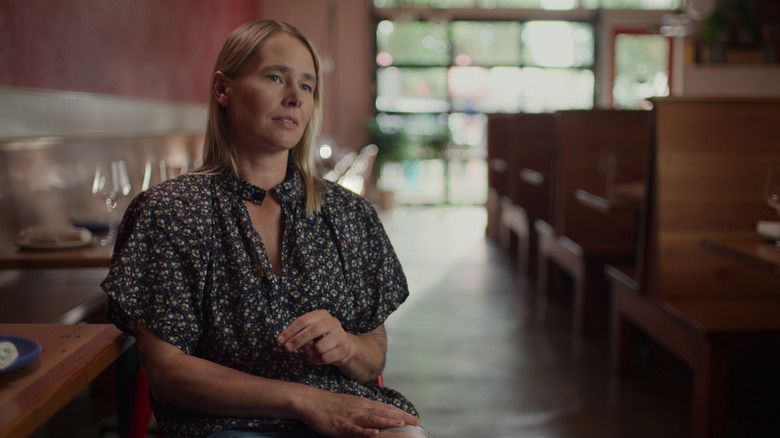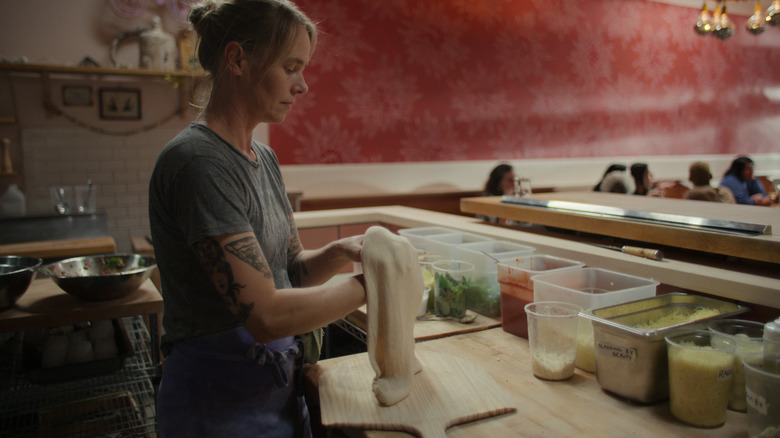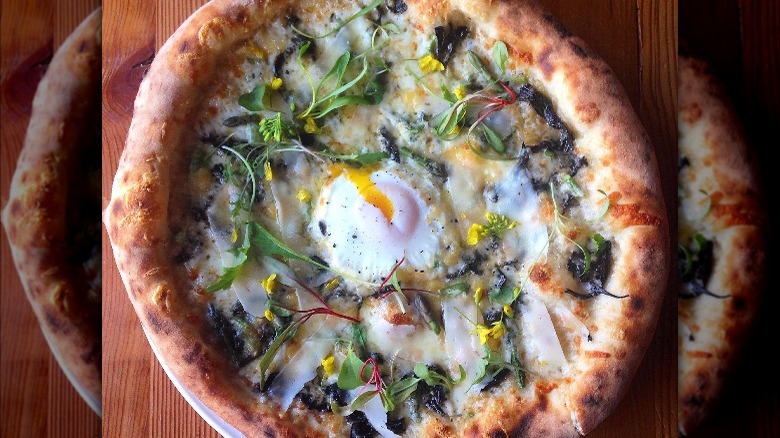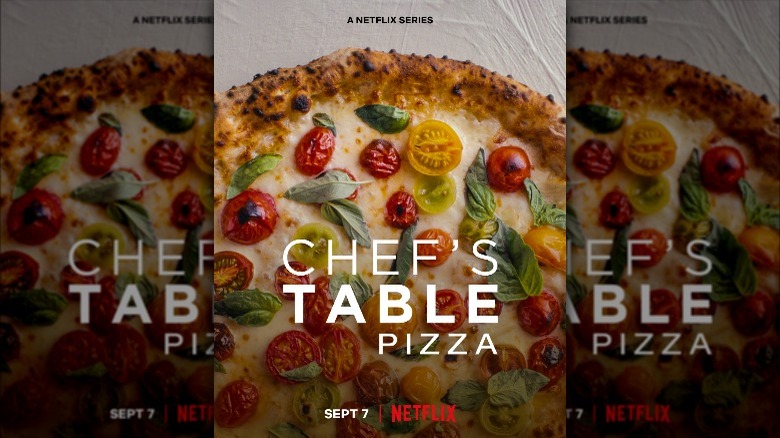Sarah Minnick Brings Artistry And Unusual Ingredients To Chef's Table: Pizza - Exclusive Interview
Netflix's long-running "Chef's Table" series recently premiered with a new season, this one entirely focused on pizza. If you've yet to watch this docuseries, it essentially looks at a selection of chefs from around the world and their differing approaches to various foods. This season, viewers watch chefs from Italy, Japan, Minneapolis, Phoenix, and beyond as they put their own spins on the international favorite: pizza.
However, "Chef's Table: Pizza" is about far more than just pizza. As viewers get to know each chef featured in each of the six 45-minute episodes, they also learn about each chef's personal ethos, background, successes, and failures. Pizza is just the start of a greater conversation, and in the sixth episode of this season — which follows the story of Portland, Oregon's Sarah Minnick and her work at her restaurant, Lovely's Fifty Fifty — the conversation evolves to also include agriculture, seasonal eating, and the many challenges and rewards that come with the restaurant business in general. Minnick, who was previously an artist before becoming a restauranteur and chef, is depicted as an artist in the kitchen, too, covering her pizzas in foraged ingredients and flowers for bright and beautiful results.
In an exclusive interview, we spoke to Minnick about her approach to pizza and her passion for her work.
The perfect combo
When you were creating the concept for Lovely's Fifty Fifty, how did you come to pizza as half of the restaurant's focus? Why not some other food that went well with ice cream?
Working at the restaurant that we had previously, the chef — Troy — and I would go down to the Bay Area, and we went to Chez Panisse. We had their little pizzettes there, and they were always interesting. I was like, "These are super different from any pizzas I've ever seen." They'd have salt cod brandade on them and lots of vegetables, and I was like, "I never really thought of this as pizza, but they're so good. They're so much better than what I think of."
There were a couple other pizza places down there that were spin-offs of Chez Panisse ... and I saw that they were using a lot of farm produce. I got excited about that, and I [thought] ... "We could bring all the farmers in and use all the same people, but we could have more of a family-friendly restaurant, one that people could come to every week."
[For] pizza and ice cream, I didn't see that happening anywhere, but I was like, "This is the best combo. It seems a little too perfect." One reviewer was like, "I'm a little worried about this pizza-ice cream thing." I was like, "What? Worried? How are you worried?"
We did have some pizza places in Portland and they were really good and nationally recognized, but they weren't farm-driven. Sometimes, people have a different expectation of pizza. People were thinking, "How is that going to work? Pizza with ice cream?" But it didn't seem that strange to me.
There were a lot of seasonal ice cream places down [in] the Bay Area, too, and we didn't have any ice cream up here yet, so I saw it as a great opportunity to infuse whatever we wanted to do in this simple way and work with all the farmers from Oregon that we had been using for all those years before.
Following the rules of seasonality
On the topic of farmers and using all of this farm fresh produce and ingredients — when I think of going to the farmer's market, I think of tomatoes and corn and green beans, things like that. How did you go from using your "typical" farmer's market haul to using all of these unique ingredients that you use and that viewers see you using on the show?
It had to do with when I started to work with Ayers Creek Farm, which we visit in the show ... They had this amazing ethos of growing a lot of wintertime produce, different kinds of squash, and they grew a lot of storage crops like beans and corn. Once I started to hang out with them and listen to what they had to say and watch their ethos for farming, I started to think, "I like this idea of eating so seasonally that you have rules to follow and you don't really bend them." You make sure that you use brussels sprouts and you use kale and you put up a lot of storage crops to be used in the winter.
Also, once I started to go to the farmer's market religiously — in the summer there are three days a week where I go, and I get a lot of farm deliveries to Lovely's, too — I started to watch the farm list and be like, "They have brussels sprouts, kales, parsnips, turnips, and potatoes. All right, we're going to work with these."
[The variety] is pretty plentiful. We have very mild winters here, and it takes a lot to shut a farm down, even in January or February. They're still delivering for us and growing great crops that do well in cold weather. Some of them can freeze in the field, and then, when they thaw, you harvest them. Once I started to go through a couple of years of working with farmers, I started to see what they had and what made sense.
Along those lines, geography plays a big role in what you've done. Do you think that you would've ended up in the same line of work, or do you think you would've been so successful with the restaurant, had you been somewhere that's not Portland?
It would depend on the farms. I can't imagine going back to not using farms year-round, and here, luckily, we're not going to have to. But that is a good question ... It's about digging into what's around and what's available. You could be surprised, for sure ... Almost any town that you visit, any major town, will have a farmer's market, especially in the summer. It's becoming more prevalent. People know and appreciate the quality that you can get from buying from a farmer and seeing exactly what you're getting.
I hope we can dig into this more environmentally friendly way of eating where you eat what's in season. You're not trucking stuff all the way around the world. You're not wanting things in the middle of winter that only grow in the summer. In January, you can get cherry tomatoes at the store, but they're not good. They're not worth eating ... It's time to get back on board with the things that actually are good in their seasons, and try to notice the differences and notice the value of that kind of eating.
Lovely Fifty Fifty's most unique offerings
Now, possibly a harder question: What's your favorite pizza?
I definitely have a big soft spot for the stinging nettles pizza that we make here. I love potatoes on pizza. That's probably one of my other favorite ingredients, and I like them with nettles. Right now, we have them with fresh collard greens, and that's probably my standout. We always have a potato pizza on the menu. That one would be one of my favorites at any given time.
If you're not eating pizza or ice cream, what are you eating?
I eat a lot of pasta. I eat a lot of soup. I love simple roasted vegetables, and I eat a lot of risotto-type items with brown rice. I love different grains. Our state is really good at growing different grains; we have Camas Country Mill in Junction City, and they grow a lot of the flour for our pies. They also have expanded out to growing buckwheat and barley, and those things make good risottos and different kinds of soups.
What is the most unusual or unique item that you've put on a pizza?
It's definitely some of those more typically Italian crops like cardoons. The fenugreek greens are one for sure and a lot of the foraged things like nettles.
We have a forager who goes out and he does a wildflower mix, which is beautiful. He's kind of a burly, tough forager guy, but then he goes out and picks little wood daisies and wood violets and things and assembles this gorgeous mix that we can put on top [of our pizzas] in the spring. It's so nice ... We're the only ones in the world to do that, so that might make it a little more unusual, but it's because we're lucky to have people like him.
What about for the ice cream? What do you think is the most unusual combination you've done there?
We infuse a lot of flowers and herbs into it. Those flavors tend to be the more unusual ones, like fresh chamomile flowers in ice cream. It's so delicious ... The fig leaf ice cream, which is in the show, is pretty unusual.
A singular experience
What was the "Chef's Table: Pizza" filming process like for you?
It was intense. It was a lot. It was two weeks long ... It was also intense because it was Covid and we were actually closed, so we had to try to pretend to be open — pretend to have employees, pretend not to be worried about Covid, the whole thing. It would've been easier if that wasn't going on, too, but everyone was a little nervous. It's a big crew of people who are all really nice, but it's a lot of grueling days, long days. There are a couple of points where I see myself on the show and I was pretty tired.
But it was really fun, too, and I knew it was a singular experience ... We closed the restaurant for those two weeks, so that was great, actually. We would never be able to do that now. We have a full staff and we couldn't close. But that way, they could set up all their equipment. We could be at their whim as far as being ready to film all day, doing one thing, so that part was good.
What's next for you? Do you have plans for another restaurant or an expansion? What are you looking forward to in the future?
This is it. This has turned into my life's work, and for my family, too. We don't have any plans or desire to open another place. This is it. It's just a little place. It's going to keep going. It's not really something you could expand, because it would lose some of its charm. Also, I think we would get sick of it. It would become something that was unsustainable for us.
Running a restaurant is a huge amount of work, so what keeps you going?
I always find a renewed passion for it, which is great. It has been long, hard work, but I enjoyed all of it. For my sister and I, we have basically made this our second home. It can be intense and it can be stressful and it can be tiring and all those things, but it's incredibly rewarding and it's also very comfortable — and it's something you wouldn't do for anyone else. We wouldn't be here for anyone but us.
All six episodes of "Chef's Table: Pizza" are now available for streaming on Netflix.
This interview was edited for clarity.
